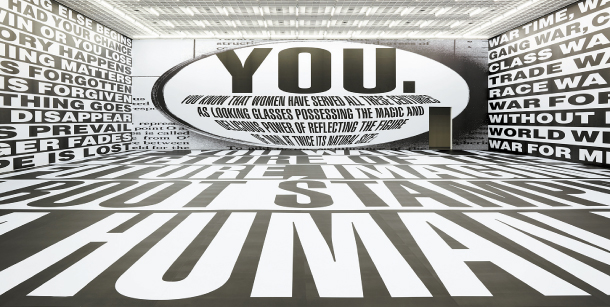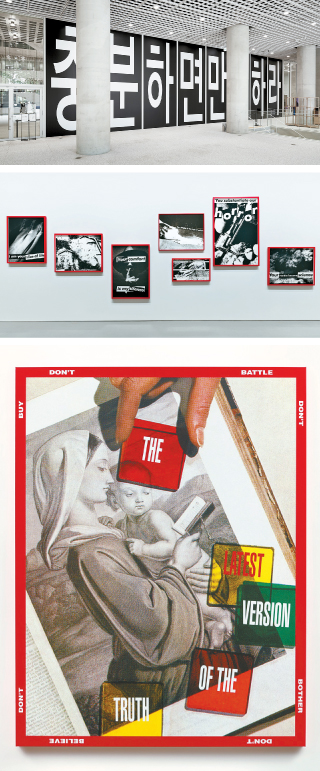Barbara Kruger has some choice messages for YOU: They deal with sexism, consumerism and a ‘loser’ named Trump

“Barbara Kruger: Forever,” which the Amorepacific Museum of Art (APMA) is holding to celebrate its first anniversary, is the American artist’s first solo exhibition in Asia. The main installation is “Untitled(Forever)” (2017), pictured above, which features excerpts from literary classics like “1984” in large block letters. [APMA]
In a new exhibition at the Amorepacific Museum of Art (APMA) in central Seoul - Kruger’s first solo show in Asia - visitors can get a closer look at the influential artist’s original paste ups as well as her more recent installation and video works.
“Barbara Kruger: Forever” opens with one of two new works in hangul, the Korean alphabet, that the 74-year-old created for the show. It’s a six meter-tall (19.7 feet), white-on-black digital print featuring the Korean translation of “Plenty should be enough,” a phrase that has repeated in the artist’s works as a comment on consumerism.
Not knowing hangul, Kruger employed the help of her friend and colleague Professor Kwon Mi-won from UCLA to finish the Korean pieces, according to curator Kim Kyung-ran during a press briefing ahead of the exhibition’s launch last Wednesday.

From top: “Untitled(Plenty should be enough)” (2019) is one of two works in hangul, the Korean alphabet, that Kruger is presenting for the first time at “Barbara Kruger: Forever.” Middle: Some of Kruger’s early texts overlaid on black-and-white photographs, dating back to the 1980's. Above: “Untitled(The latest version of the truth)” (2018) is a jab at how perceived wisdom may be found faulty in the future. [APMA]
“Untited(Forever)” (2017), the exhibition’s first room and main installation, gives the show its name. Its huge letters in alternating black and white cover the entirety of the walls and floor. Departing from her usual style, Kruger borrowed excerpts from literary classics to express her views on power structures and equity for this installation.
The word “YOU” is prominently stamped across the front and back walls as if Kruger is directing her message straight at the viewer. An excerpt from Virginia Woolf’s “A Room of One’s Own” fills one wall: “You know that women have served all these centuries as looking glasses possessing the magic and delicious power of reflecting the figure of man at twice its natural size,” it reads.
“If you want a picture of the future, imagine a boot stamping on a human face - forever,” taken from George Orwell’s “1984,” covers the floor.
The next space displays 16 of the artist’s original paste ups including “Untitled(Your gaze hits the side of my face)” that date back to 1981, the year Kruger perfected her signature text-on-photograph technique. Looking closely, viewers can see pen marks, dried glue and other traces of manual methods Kruger used to create the collages by cutting up texts and pictures from books and magazines. The artist’s other hangul creation, a large bright red print that reads “Please laugh Please cry,” is also on view.
The rest of the show is dedicated to Kruger’s later works, such as her contributions to the magazine “Dazed & Confused” in 1996 and the 2007 “Face It” series, through which Kruger expresses anti-consumerist sentiments. A four-channel video installation entitled “The Globe Shrinks” (2010) is a 13-minute commentary on modern society intercut with Kruger’s block texts. One scene gives the viewer a first-person perspective of an inmate getting beaten up by his cellmates.
An archive room holds posters and magazines designed by Kruger, including the pre-election Oct. 31, 2016 issue of New York Magazine that features the word “loser” pasted across a close-up of President Donald Trump’s face. The “Your Body is a Battleground” poster Kruger designed for a pro-choice march supporting abortion in Washington in 1989 is displayed as well.
Although Kruger was in Korea for a few weeks prior to the exhibit’s opening, she didn’t participate in the press briefing.
“The artist believes that bringing a camera to her face is an extremely violent behavior,” Kim explained.
But she is keen on what’s happening in Korea, Kim told reporters. “Kruger is very interested in current affairs, and knows quite a lot about BTS and mukbang on YouTube.”
BY KIM EUN-JIN [kim.eunjin1@joongang.co.kr]
“Barbara Kruger: Forever” runs until Dec. 29. Tickets are priced at 13,000 won ($11.24) for adults and 9,000 won for students. The museum opens 10 a.m. to 6 p.m. except Mondays. For more information, visit apma.amorepacific.com.










with the Korea JoongAng Daily
To write comments, please log in to one of the accounts.
Standards Board Policy (0/250자)